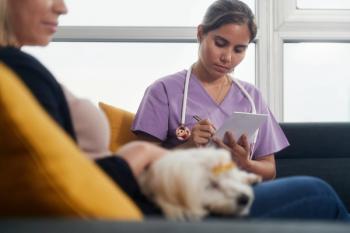
"Ugh, why does my dog always pull on the leash!"
Help your veterinary clients understand the motivation behind this normal behavior in dogs and how to fix it.
"I'm ready for my walk!" (Getty Images)“Dogs are social creatures living in inconsistent and confusing social systems where inadequate attention to their social needs is the norm.”
E'Lise Christensen, DVM, DACVB, dropped this sobering statement during her CVC Kansas City presentation on unruly behavior in dogs. The very definition of unruly behavior is normal behavior that owners don't like. One example she discussed is pulling on a leash, which is one of the more difficult unruly habits to fix.
Factors involved:
- People walk too slow for a dog's natural pace.
- The world is much more interesting than staying by the owner's side.
- To fix it, both the owner AND the dog must be patient and have good impulse control. (Yeah, we did mention this behavior is a harder one to fix, right?)
Basic interventions for owners facing this problem: Try a head halter, a harness that attaches at the front of the dog (don't use one that attaches at the back; Christensen says this enhances a dog's desire to pull) or even a leash that goes around the client's waist. Clients can also reward the dog with a treat every few steps while the dog is walking at an appropriate distance from the owner. And they should walk faster and keep the walk interesting. How? Allow the dog to periodically stop and sniff.
“To never allow a dog to sniff on a walk is denying a dog's primary sense of the world,” says Christensen. Letting them get a noseful once in a while is one small way you can restore a little of dogs' denied social needs.
Newsletter
From exam room tips to practice management insights, get trusted veterinary news delivered straight to your inbox—subscribe to dvm360.






